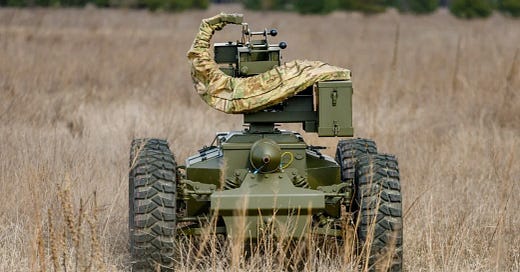Ground Drones are Certainly Trendy
But the current UGVs seem like a waste and rely on inept enemies to work. Combat UGVs need to be much better to overcome their high potential:reality ratio
Ukraine is testing wire-guided ground suicide drones. FFS, Why?
Ukraine already uses ground drones for logistics. It wants them for combat, too. But they are small so the usage is limited:
At the moment, Ukraine is looking to use fiber-optic-controlled variants for kamikaze strikes and high-risk combat operations and not for logistics.
What's the point? What does this do that a decades-old wire-guided missile doesn't do? Or if you must have a drone (because they're the chrome and tail fin of weapons today), use an aerial wire-guided suicide drone.
While the test above is with a UGV equipped with a machine gun, others say the value is the big boom:
Ukrainian soldiers use ground robots to blow up Russian troops and equipment. These carry a far heavier explosive payload than drones that fly. ...
He said that while the biggest aerial drones can carry mines that weigh 22 pounds each, the smallest ground robots that he works with can take more than 48 pounds. On average, they can carry much more.
The article notes a 66-pound payload for one UGV suicide drone.
But a rocket from a HIMARS or similar launcher has 51 pounds of explosives. A GLSDB has a 35-pound explosive payload. And aircraft could drop even larger payloads.
A problem with ground drones isn't the command link to avoid obstacles (back to the first link):
“The platform must have reliable communication because it can be easily lost due to terrain distortions or other obstacles,” Kanevsky noted. “The robot must be cross-country, that is, not get stuck in grass, snow, sand, and mud.”
None of those more traditional warheads have to worry about dread "grass" thwarting them. Can the suicide UGVs really get closer to the target than a precision warhead using just inertial guidance capability?
The problem with the UGVs is their small size. World War I tanks were large to be able to maneuver through trenches, barbed wire, machine gun fire and shrapnel, and shell holes without being stopped. FFS, if your UGV is being stopped by grass it is too small to be a ground vehicle.
Is this the next wire-guided UGV to be developed?
Seriously, a little engineering support or even just some troop initiative will keep those small drones from getting close enough to detonate with any lethal effect.
Good Lord, in my Army basic training field exercise, one night in our circular bivouac sitting in our firing positions, our drill sergeants “attacked” us. But not in my squad’s section of the perimeter.
Before night fell, I seeded the front of our section of the line with sizable rocks. It was a mine field of sorts. So that night when we were attacked, I heard some running, commotion, and swearing as the attackers stumbled into and on the rocks. Then we heard no more activity outside our line.
Yet even without any natural or created obstacles that could achieve what grass can do, how could any decent troops allow a UGV to crawl close to their position? It should have been spotted and lit up with the unit’s organic weapons. Sure, whoever fired would have to move after disclosing their position. But that’s combat, eh?
Other than smaller UGVs carried by infantry for room-, bunker-, or cave clearing, UGVs will need to replace tanks for missions. A slow, crawling warhead has limited uses and will not replace artillery, rocket and air delivered warheads.
And I suspect those means using warheads carrying loitering submunitions could replace a lot of the suicide drones, too.
World War I witnessed the first tanks and the first steps toward restoring movement to a firepower-drenched Western Front stalemate that devoured men and materiel to shove an enemy back or hold the line. We have witnessed the first steps in a battle in the Winter War of 2022 near Lyptsi toward the equipment and tactics that could restore movement to the stalemated integrated strike complex warfare that links persistent surveillance with timely precision fires.
I recounted that Ukrainian attack and suggested the preparations for and actual attack on Hamel in World War I suggests a means to advance beyond these first small UGVs.
We’re not even close to a Hamel-level attack capability. And we won’t as long as the drones are these tiny toy-like vehicles that are easily defeated by terrain or simple obatacles.
NOTE: The picture of the UGV seeing if it can traverse grass is from the article. I generated the second image with the Substack capability.





